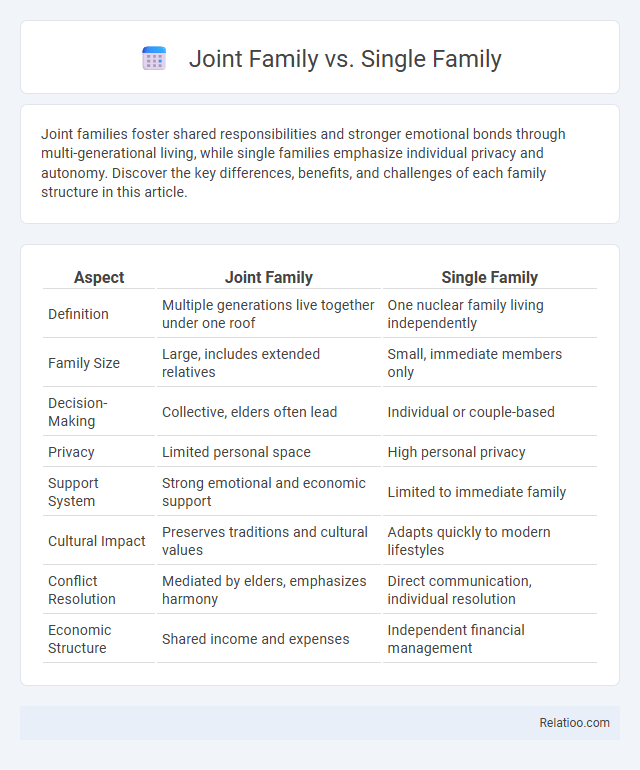Joint families foster shared responsibilities and stronger emotional bonds through multi-generational living, while single families emphasize individual privacy and autonomy. Discover the key differences, benefits, and challenges of each family structure in this article.
Table of Comparison
| Aspect | Joint Family | Single Family |
|---|---|---|
| Definition | Multiple generations live together under one roof | One nuclear family living independently |
| Family Size | Large, includes extended relatives | Small, immediate members only |
| Decision-Making | Collective, elders often lead | Individual or couple-based |
| Privacy | Limited personal space | High personal privacy |
| Support System | Strong emotional and economic support | Limited to immediate family |
| Cultural Impact | Preserves traditions and cultural values | Adapts quickly to modern lifestyles |
| Conflict Resolution | Mediated by elders, emphasizes harmony | Direct communication, individual resolution |
| Economic Structure | Shared income and expenses | Independent financial management |
Introduction to Family Structures
Family structures categorize households based on composition and relationships, with joint families typically consisting of multiple generations living together, sharing resources and responsibilities. Single-family units usually involve a nuclear setup with parents and their children residing independently, emphasizing privacy and direct parental control. Understanding these family structures provides insight into cultural, economic, and social dynamics shaping individual and communal lifestyles.
Defining Joint Family
A joint family refers to an extended family structure where multiple generations live together under one roof, sharing resources and responsibilities. This arrangement fosters strong social bonds, collective decision-making, and mutual support among family members. In contrast, single-family units typically consist of nuclear families with parents and their children living independently.
Defining Single Family
Single family refers to a household consisting of one nuclear family unit, typically two parents and their children, living independently in a separate dwelling. This family structure emphasizes privacy, individual decision-making, and economic self-sufficiency without shared resources or responsibilities with extended relatives. Compared to joint families, single families have fewer members, limited support systems, and distinct social dynamics centered around isolated family bonds.
Historical Context and Evolution
Joint family systems, deeply rooted in agrarian and pastoral societies, historically fostered collective living with shared responsibilities and resources, enhancing social cohesion and economic stability. Single-family units gained prominence during industrialization as urbanization and economic shifts prioritized nuclear households for mobility and individual economic independence. Family structure evolution reflects socio-economic transformations, with joint families prevalent in traditional rural settings and single-family models dominating modern urban landscapes due to changing cultural values and economic demands.
Economic Implications of Both Families
Joint families often share resources and expenses, leading to reduced per capita costs and greater financial stability for members. Single families typically face higher individual financial burdens due to separate living expenses and limited income pooling. Understanding your family structure's economic implications can guide informed decisions on budgeting, resource allocation, and long-term financial planning.
Social and Emotional Support Systems
Joint families offer a robust social and emotional support system by fostering close-knit relationships and shared responsibilities among multiple generations. Single-family structures provide individualized attention and autonomy but may experience limited immediate social support during emotional challenges. Understanding your family structure helps optimize available support networks to enhance emotional well-being and social connectivity.
Privacy and Personal Space Comparison
Joint family living often limits your privacy and personal space due to shared common areas and multiple members under one roof, creating a more communal environment. In contrast, single-family homes typically provide greater individual privacy and personal space by housing fewer people, allowing more control over living areas. Family structures significantly influence the degree of privacy you experience, with nuclear families generally affording more seclusion compared to extended joint families.
Impact on Children’s Development
Joint family structures provide children with a strong support network and cultural continuity, promoting social skills and emotional security through shared caregiving. Single-family environments often offer more individualized attention and stability, enhancing autonomy and self-esteem in children. Family structure significantly influences developmental outcomes, where cohesive relationships and consistent parenting styles are key factors in children's cognitive, emotional, and social growth.
Challenges Faced by Joint and Single Families
Joint families often face challenges related to privacy, conflicting opinions, and resource allocation among multiple generations living together. Single families, on the other hand, struggle with emotional support scarcity, financial burdens, and isolation, especially in nuclear setups lacking extended family networks. Both family structures must navigate balancing individual needs with collective responsibilities to maintain harmony and well-being.
Choosing the Best Family Structure
Choosing the best family structure depends on your personal values, lifestyle, and support needs, with joint families offering shared responsibilities and social support, while single families provide greater privacy and independence. Joint family systems often foster close-knit relationships and resource sharing, whereas single families emphasize autonomy and flexibility in decision-making. Evaluating the benefits and challenges of each structure helps determine which aligns best with your long-term goals and family dynamics.

Infographic: Joint Family vs Single Family
 relatioo.com
relatioo.com